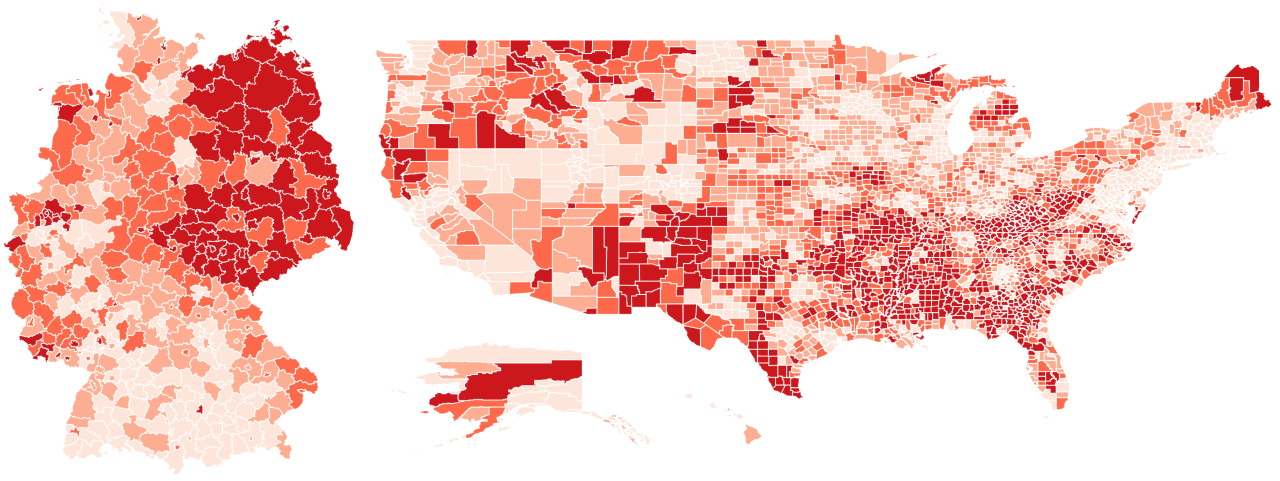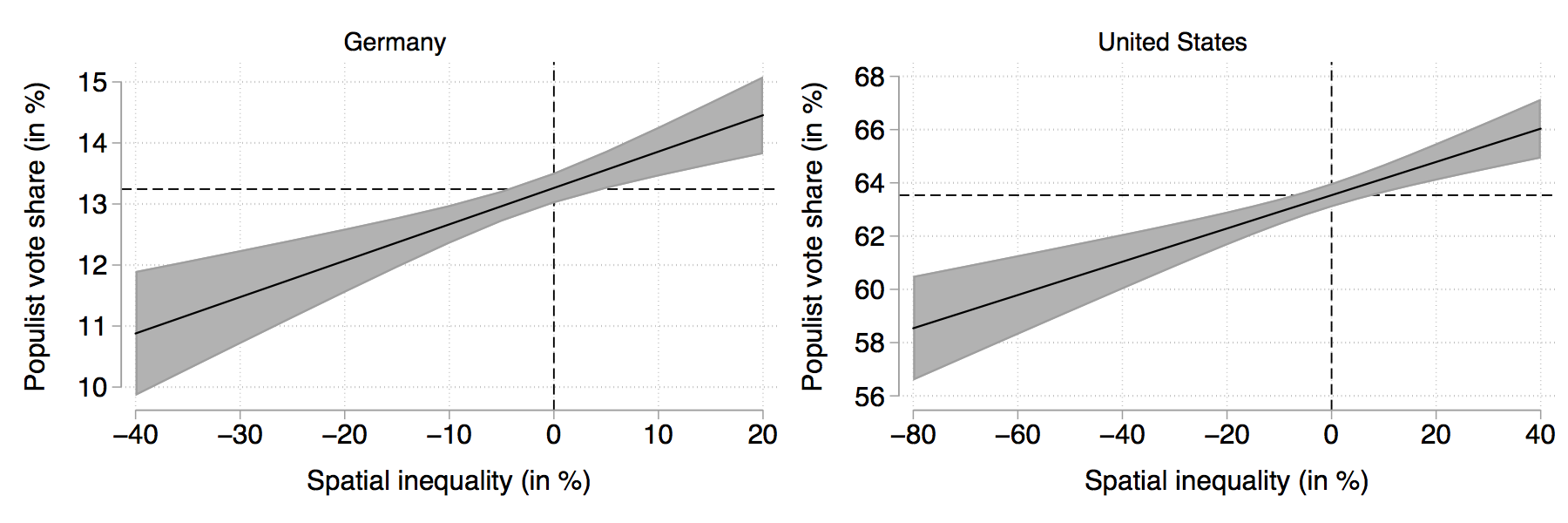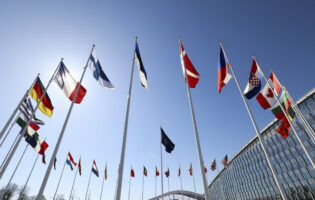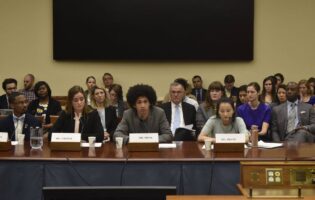
Ted Eytan via Flickr
Spatial Inequality and Populist Voting in Germany and the United States

Michael Bayerlein
DAAD/AICGS Research Fellow
Michael Bayerlein is a doctoral researcher at the University of Kiel and a research associate at the Kiel Institute for the World Economy. Mr. Bayerlein holds a Master’s degree in Political Science and Public Internal Law from the University of Kiel as well as a Bachelor’s degree in Political Science from the University of Mannheim. His research interests are located at the intersection of political science and economics with a special focus on political economy, party politics, electoral behavior, globalization, and populism, with a strong focus on quantitative methods.
Michael’s dissertation is concerned with the various facets of current and historic electoral breakthroughs and rule of populist parties and politicians. His research specifically centers around the determinants and consequences of populism with a focus on identifying common causes and working out short- as well as long-term ramifications.
During his fellowship at AICGS, Michael will analyze the regional differences in right-wing populist voting in Germany and the U.S. In order to do so, he introduces the concept of “spatial inequality,” which is the relative economic inequality between subnational regions. Using household income data from Germany and the U.S. on the regional revel, Michael develops a measure of relative regional inequality and models this inequality as a determinant of right-wing populist voting in both countries.
The DAAD/AICGS Research Fellowship is supported by the DAAD with funds from the Federal Foreign Office.
Although having lost the U.S. presidential election, the number of votes won by populist president Donald J. Trump still exceeded many expectations. Similarly, the populist German party Alternative für Deutschland (AfD) experiences continuing support amongst voters. United in their populist rhetoric, the AfD and Mr. Trump claim to speak for “the people” and against “the elite.” The resonance of campaign slogans like “take back your country”[1] and “make America great again”[2] suggests the existence of societal grievances. Research concerned with these grievances and the determinants of populist voting often focuses on economic and cultural changes as well as rising inequality, all usually associated with progressing globalization.[3]
But surprisingly, populist voting in Germany and the United States is highest in less globalized regions with rather equal income distributions like Saxony and the Ruhr area in Germany[4] as well as the Deep South and the Rust Belt states in the United States.[5] These patterns are even more pronounced on the county level, with rural areas not directly affected by the forces of globalization displaying particularly high populist vote shares.[6] In light of these findings, this essay addresses the question of how the county variance in populist support in Germany and the United States can be explained. The answer I propose is that populist voting can in part be explained through globalization induced spatial inequality, which describes the regional inequality that arises as some counties strongly benefit from globalization while other less globalized counties are left behind. To make this argument I shift the focus away from absolute inequality within counties and the direct effect of globalization towards relative inequality between counties and thereby the indirect effect of globalization.
Globalization Induced Inequality and the Populist Appeal
In analyzing the uneven spread of globalization benefits, research has found evidence that globalization both reduces and increases inequality.[7] This polarized picture often stems from different measurements and methods. Not only is it difficult to capture the effects of globalization, but it is also problematic that inequality can be defined in multiple ways.[8] Despite these conceptual ambiguities, many scholars point to a general pattern in recent decades: Globalization achieves a drop of inequality between nations, but inequality surges within nations because of the uneven spread of globalization benefits.[9] The question arises how this inequality manifests itself.
Globalization and Spatial Inequality
In this essay, I propose a new measurement of globalization inequality that I term spatial inequality. Spatial inequality captures regional inequality by quantifying the income deviation within countries on the county level. The county-specific spatial inequality is the percentage deviation of a county’s median household income from the national median income average. The fraction is multiplied by -100 so that the score gives a percentage point difference with high values indicating high spatial inequality. To shed further light on spatial inequality, Figure 1 shows the county-specific scores in Germany and the United States.
Figure 1: Spatial inequality in Germany and the United States

Notes: The figure shows the spatial inequality in Germany (left map) and the US (right map) on the county level. Darker regions indicate a higher spatial inequality. The spatial inequality score is the percentage deviation of a county’s median household income from the national median income average with positive values indicating higher spatial inequality. The data comes from the German Federal Statistical Office and the U.S. Census Bureau.
The figure shows that both countries display a large variance in spatial inequality on the county level. The values range from -74 percent to 27 percent in Germany and -172 percent to 56 percent in the United States. It is interesting to note that the spatial inequality range is significantly larger in the United States with the county showing the highest spatial inequality deviating by 56 percent from the national median income average, a number twice as high as in Germany.
The figure also shows regional clusters of spatial inequality. In Germany, spatial inequality is most pronounced in Eastern Germany with some clusters in Western Germany, like in the Ruhr area, an industrialized former mining region. In the United States, the picture is more diverse, with pronounced clusters in the Deep South, the Northwest, and New Mexico but also several smaller clusters in less populated counties. Based on this first descriptive insight the question arises whether spatial inequality can explain populist voting.
Spatial Inequality and Populist Support
In this essay, I argue that spatial inequality increases the societal polarization between rich counties and counties left behind, which in turn creates favorable conditions for the populist anti-elite rhetoric that “the rich and corrupt elite” is not acting for the benefit of “the hard working, left-behind people.” This populist “we vs. them” rhetoric usually centers around three different groups: the elite, the majority, and the minority.[10] Despite this rhetoric, populist actors provide narratives who this “elite” and “minorities” are for the purpose of political mobilization. In order to achieve this mobilization, the narratives have to resonate with pre-existing cleavages salient in society, ultimately determining the specific form of populism, i.e., left-wing populism if the mobilization occurs along an economic cleavage and right-wing populism if the mobilization narrative is rooted in a cultural conflict dimension.[11]
Counties with higher spatial inequality also display higher vote shares for right-wing populist actors.
In Germany and the United States, the cultural conflict dimension is highly salient in societies, making a high vote share for right-wing populists more likely. However, this is not to say that even right-wing populist actors cannot also address economic grievances. Rather, the argument is that cultural in-group vs. out-group conflicts can be activated by economic grievances like spatial inequality and lead to surges in populist voting even though the populist actors do not directly address these economic but cultural grievances. Thus, spatial inequality as an economic phenomenon can affect populist voting directly or indirectly and activate hostilities towards minority groups. To show the connection between spatial inequality and populist voting, Figure 2 displays the correlation between spatial inequality and populist voting in Germany and the United States.
Figure 2: Spatial Inequality and Populist Voting in Germany and the United States

Notes: The figure shows the correlation between the vote share of the AfD in Germany (left figure) as well as Mr. Trump in the United States (right figure) and the respective spatial inequality scores. The model is created by running an OLS regression analysis with fixed effects. The data comes from the German Federal Election Commissioners Office, German Federal Statistical Office, the University of Stanford and the U.S. Census Bureau. The figure plots the correlation between the 1st and 99th percentile of the spatial inequality distribution. The dashed vertical line indicates the spatial inequality average. The dashed horizontal line gives the average vote share on the county level. Note that the average county populist vote share in Germany and the United States diverges from the national vote share. This is due to the fact that counties are differently sized with small and large counties but equally weighted when calculating the county average vote share.
From the figure, it follows that counties with higher spatial inequality also display higher vote shares for right-wing populist actors. This empirical finding strongly supports the previous argument on the connection between spatial inequality and populist voting. However, when looking more closely at the data it becomes evident that some counties display high spatial inequality but nevertheless only show moderate populist support. The question becomes how these counties are seemingly able to cushion the blow of spatial inequality so that economic grievances do not translate into populist voting.
How to cushion the blow?
In this last section, I argue that the provision of public goods is a crucial component in mediating the effect of spatial inequality on populist voting. This is because the inequality-founded feeling of being left behind is reinforced by inadequate public good provision, i.e., medical care, education facilities, public transport, or broadband internet. Previous contributions have already shown that sparsely populated rural areas display a particularly high populist vote share when they lack comprehensive public good provisions.[12] The proposed mechanism that connects the lack of public good provision to populist voting closely resembles the mechanism outlined above. It is the same feeling of abandonment by an elite that is perceived as increasingly distant and not interested in the needs of people in non-prospering rural areas.[13]
The highest populist vote share is found in counties with high spatial inequality and low provision of public goods… counties with high spatial inequality but similarly high provision of public goods also display low populist support in both countries.
While both factors – spatial inequality and public good provision – seemingly correlate with populist voting, I propose that both factors reinforce each other in that counties affected by spatial inequality show less populist support if the provision of public goods is adequate. To analyze this argument empirically, I use data from Germany and the United States on the provision of public goods in terms of medical care, education, travel infrastructure, and internet infrastructure.[14] Figure 3 plots the previously shown correlation between spatial inequality and populist voting but with the additional inclusion of the degree of public good provision.
Figure 3: Spatial Inequality and Populist Voting with Public Good Provision Scenario

Notes: The figure shows the predicted populist vote share depending on the degree of spatial inequality and public good provision in Germany (left figure) and the United States (right figure). The model is created by running an OLS regression analysis with fixed effects. The public good score is calculated by combining standardized variables on public goods (medical infrastructure, education, traffic infrastructure, broadband internet access) equally weighted into a score ranging from 0 to 10. The data comes from the INKAR dataset (www.inkar.de) and the PolicyMap data (www.policymap.com). The figure plots the correlation between the 1st and 99th percentile of the spatial inequality distribution.
The figure shows how spatial inequality and the provision of public goods reinforce each other. From blue to red, the figure shows the predicted populist vote share depending on spatial inequality and provision of public goods. The highest populist vote share is found in counties with high spatial inequality and low provision of public goods (lower right corners). Mirroring this, populist support is low in counties with low spatial inequality and high provision of public goods (upper left corners). Most interestingly and in strong support of my argument, counties with high spatial inequality but similarly high provision of public goods also display low populist support in both countries (upper right corners). This supports the idea that the effect of spatial inequality on populist voting is weakened by the provision of public goods. From this, it can be cautiously concluded that the provision of public goods can cushion the blow of spatial inequality.
Conclusion
This essay addressed how the county variance in populist support in Germany and the United States can be explained. To answer this question, I proposed that spatial inequality is a crucial component in explaining the variance in populist voting. Further, I argued that the connection between spatial inequality and populist voting is mitigated by the provision of public goods. Supported by an empirical analysis, I found that spatial inequality correlates significantly with populist voting in Germany and the United States and that the effect of spatial inequality on populist voting is reduced if the provision of public goods is adequate.
From this follows that economic grievances can pave the way for the populist rhetoric and foster the activation of pre-existing group conflict narratives. In terms of policy advice, this means that public goods can mitigate economic grievances and thereby reduce voters’ susceptibility to group conflict narratives. But economic grievances only “activate” the pre-existing conflict potential that can then be exploited by populists. The provision of public goods does not resolve the existing in-group vs. out-group conflict narratives salient in society. Based on this, public goods can alleviate the symptoms, but not the cause.
The provision of public goods does not resolve the existing in-group vs. out-group conflict narratives salient in society. Based on this, public goods can alleviate the symptoms, but not the cause.
Although providing a first insight into the possible connection between spatial inequality, the provision of public goods, and populist voting, further research has to be conducted to shed more light on the causal mechanism and the robustness of the empirical results. In particular, future research has to include additional factors that might affect the relationship between spatial inequality and populist voting, like cost of living in a certain county, demographic difference as well as a deeper analysis of the urban-rural divide. Irrespective of these open questions, the essay has provided first and important results on the impact of spatial inequality on populist voting. For the transatlantic partnership between Germany and the United States, the results indicate that there is an increasing need for a joint approach to not only grow together economically but to also jointly ensure prosperity for everyone.
Supported by the DAAD with funds from the Federal Foreign Office (FF).
[1] Bundeszentrale für politische Bildung (Federal Center for Political Education), „Alternative für Deutschland (AfD)“ by Jochen Franzke, August 2, 2019, URL: https://www.bpb.de/politik/wahlen/wer-steht-zur-wahl/brandenburg-2019/294116/afd.
[2] “How Donald Trump came up with ‘Make America Great Again’”, The Washington Post, January 18, 2017, URL: https://www.washingtonpost.com/politics/how-donald-trump-came-up-with-make-america-great-again/2017/01/17/fb6acf5e-dbf7-11e6-ad42-f3375f271c9c_story.html.
[3] See Kriesi, H., E. Grande, R. Lachat, M. Dolezal, S. Bornschier, and T. Frey. 2008. West European Politics in the Age of Globalization. Cambridge: Cambridge University Press, Margalit, Y. 2019. \Economic Insecurity and the Causes of Populism, Reconsidered.” Journal of Economic Perspectives 33(4): 152-70. and Mukand, S., and D. Rodrik. 2020. “The Political Economy of Liberal Democracy”, Economic Journal, 130 (627): 765-792.
[4] “Why Is the Former East Germany Tilting Populist?”, Der Spiegel, November 17, 2017, URL: https://www.spiegel.de/international/germany/eastern-germany-and-its-affinity-for-populists-a-1177790.html.
[5] “Here’s the real reason Rust Belt cities and towns voted for Trump”, The Washington Post, December 20, 2016, URL: https://www.washingtonpost.com/news/monkey-cage/wp/2016/12/20/heres-the-real-reason-rust-belt-cities-and-towns-voted-for-trump/.
[6] See, for example, “So haben Sachsens Gemeinden gewählt”, Tagesspiegel, September 2, 2019, URL: https://interaktiv.tagesspiegel.de/lab/landtagswahl-sachsen-2019/, and “The Geography of Trumpism”, The New York Times, March 12, 2016, URL: https://www.nytimes.com/2016/03/13/upshot/the-geography-of-trumpism.html.
[7] Firebaugh, G. 2003. The New Geography of Global Income Inequality, Harvard University Press, and Milanovic, B. 2016. Global Inequality: A New Approach for the Age of Globalization, Harvard University Press.
[8] Ravallion, M. 2004. “Competing Concepts of Inequality in the Globalization Debate”, The World Bank Policy Research Working Papers. URL: https://doi.org/10.1596/1813-9450-3243.
[9] Niño‐Zarazúa, M., L. Roope, and F. Tarp. 2017. “Global Inequality: Relatively Lower, Absolutely Higher”, Review of Income and Wealth, 63 (4): 661-684.
[10] For more details on this and the following arguments, see Rodrik, D. 2018. “Populism and the Economics of Globalization”, Journal of International Business Policy 1 (1-2): 12-33.
[11] For an historic perspective see Funke, M., Schularick, M., and Trebesch, C. (2020). Populist Leaders and the Economy (No. 15405). CEPR Discussion Papers. URL: https://ideas.repec.org/p/cpr/ceprdp/15405.html.
[12] See, for example, Diermeier, M. (2020). Ist mehr besser? Politische Implikationen der disparaten Daseinsvorsorge in Deutschland. Zeitschrift für Politikwissenschaft, 1-30 and Rodríguez-Pose, Andrés. 2018. The revenge of the places that don’t matter (and what to do about it). Cambridge Journal of Regions, Economy and Society 11(1): 189–209.
[13] Guilluy, Christophe. 2018. No Society: La Fin de la Classe Moyenne Occidentale. Paris: Flammarion, Le Bras, Hevré. 2015. Le Pari du FN. Paris: autrement, and Franz, Christian, Marcel Fratzscher, und Alexander Kritikos. 2018. AfD in dünn besiedelten Räumen mit Überalterungsproblemen stärker. DIW Wochenbericht 8: 136–144.
[14] The data comes from INKAR Online: https://www.inkar.de/Default.









